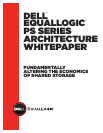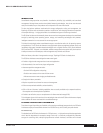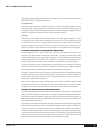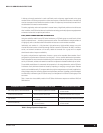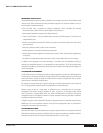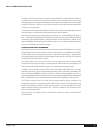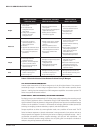
JANUARY 2008 4
DELL PS SERIES ARCHITECTURE
4
battery-backed caches and other advanced features. The disks in an array are automatically protected with
RAID (RAID 10, RAID 5, or RAID 50) and hot spares.
PS Series Group
A PS Series group is comprised of a single PS Series array or multiple arrays working together. The group
is seen as a single, shared storage service by application servers and administrators. When an array is
configured as a group member, its RAID-protected disk space is added to the group’s storage pool. Data and
network I/O to the group is load balanced across the group members’ resources.
Volumes
Administrators create volumes from the available space in the PS Series group storage pool. A volume
can be spread across multiple disks and multiple group members — this is done automatically by the
virtualization built into the arrays. The group exports volumes as iSCSI targets protected with security,
including authentication and authorization, for both discovery and access. Upon connection, hosts see
volumes as local disks. Volume snapshots and volume replicas can also be created from the storage pool.
PS SEriES grouPS FaciLitatE StoragE managEmEnt
Although comprised of one or more PS Series arrays, a PS Series Group appears to client servers as a
single entity that offers network storage access in block mode — a storage area network (SAN). Unlike
conventional SAN products, each group member “cooperates” with other members to automate resource
provisioning and performance optimization. This cooperation is a key element in the virtualization of not
only disk storage, but also controllers, caches, network links and management of the PS Series group.
The disk data served by a group is dispersed across the group members, with the placement continually
adjusted for optimal performance as resources are added or load changes occur. In addition, application
server network sessions are distributed across members to spread out the I/O requests.
The result is a storage system that scales linearly in all significant dimensions of storage capacity, network
bandwidth, application server request processing capacity and performance. In contrast, administration
remains stable as the group is expanded. There is no separate management of arrays and volumes, all
administration is performed at the group level.
With its ability to export many targets, a PS Series group can be used to consolidate storage for a wide
range of applications and servers, including e-mail, Web servers, database servers, and file/print without
compatibility or performance concerns and without a prohibitive increase in administrative expenses.
DiStributED PagE-baSED VoLumE managEmEnt
The RAID-protected disk space that each member contributes to the PS Series group’s virtualized storage
pool is partitioned into fixed-sized chunks of data, called pages. Each volume has a page map that allocates
and re-allocates pages to the members. A page map is shared by each member that contains a page of the
volume. Page maps are also used in the implementation of features like volume snapshots, replication, and
over-subscription (thin provisioning).
Page movement is a transactional operation between group members that helps ensure data integrity. Pages
can be moved transparently (that is, online and without blocking host access) across disks in a member and
across group members for automatic load balancing and to help ensure data availability. For example, to
eliminate a frequently-accessed data “hot spot,” the affected pages may be spread across different disks
or group members, without the need to move all the pages for an entire volume. The built-in load balancing
features use real-time and historical access trends, as well as capacity and status information, to help
continuously improve performance within individual arrays and the group as a whole.



